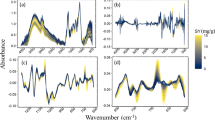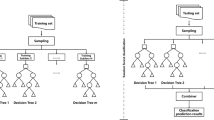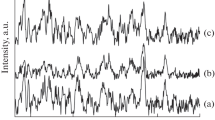Abstract
In this paper, laser-induced breakdown spectroscopy (LIBS) combined with machine learning algorithm was used to study the classification of Astragalus from 10 different origins. First, the spectrum of Astragalus from 10 different origins was collected based on LIBS technology, and support vector machine (SVM) and extreme learning machine (ELM) models were established, respectively. Their accuracy rates were 45% and 30%, respectively. After that, the feature variables were selected as the input vectors of SVM and ELM models using random forest (RF) feature importance ranking, and random forest-support vector machine (RF-SVM) and random forest-extreme learning machine (RF-ELM) models were established, respectively. Their accuracy rates were 83.33% and 58.33%, respectively. To improve classification accuracy, gray wolf optimizer (GWO) algorithm was used to optimize RF-SVM and RF-ELM, respectively, and two classification models of gray wolf optimizer-random forest-support vector machine (GWO-RF-SVM) and gray wolf optimizer-random forest-extreme learning machine (GWO-RF-ELM) were constructed. The accuracy rates of GWO-RF-SVM and GWO-RF-ELM models were 85% and 92%, respectively. The results show that the classification effect of GWO-RF-ELM is the best, and its macro-precision, macro-recall and macro-F1 score were 92%, 100%, 92.04% and 95.86%, respectively. It provides an effective method for the identification of Astragalus.

















Similar content being viewed by others
Data availability
Data underlying the results presented in this paper are available upon request.
References
H. Zhang, S.S. Ren, P. Yan, Phytotaxa 524, 199–204 (2021)
A.O. Affum, D.O. Shiloh, D. Adomako, Food Chem. Toxicol. 56, 131–135 (2013)
M.H. Shahrajabian, Appl. Ecol. Environ. Res. 17, 13355–13369 (2019)
M.S. Amiri, M.R. Joharchi, M. Nadaf, Y. Nasseh, Avicenna J. Phytomed. 10, 128–142 (2020)
J.J. Zhang, Y.M. Lin, X.H. Wei, Z.Y. Li, R.R. Li, J. AOAC Int. 105, 603–611 (2022)
L.Q. Hu, C.L. Yin, S. Ma, Z.M. Liu, Acta. A Mol. Biomol. 205, 207–213 (2018)
H. Sun, Q. Jin, Q.X. Wang, C. Shao, L.L. Zhang, Y.M. Guan, H.L. Tian, M.H. Li, Y.Y. Zhang, Ecol. Indic. 114, 106296 (2020)
S. Li, S.K. Dong, Y.S. Fu, B.R. Zhou, S.L. Liu, H. Shen, Y.D. Xu, X.X. Gao, J.N. Xiao, S.N. Wu, F. Li, Sci. Total Environ. 844, 157141 (2022)
X.Q. Ma, Q. Shi, J.A. Duan, T.T.X. Dong, K.W.K. Tsim, J. Agric. Food Chem. 50, 4861–4866 (2002)
X.D. Yuan, K.H. Ling, C.W. Keung, Phytochem. Anal. 20, 293–297 (2009)
V. Adimcilar, Z. Kalaycioglu, N. Aydogdu, T. Dirmenci, A. Kahraman, F.B. Erim, J. Pharm. Biomed. Anal. 175, 112763 (2019)
A. Przybylska, M. Gackowski, M. Koba, Molecules 26, 2135 (2021)
S. Abid, A. Maciuk, R. Fishmeister, V. Leblais, A. Legssyer, H. Mekhfi, A. Ziyyat, M. Aziz, A. Lekchiri, M. Bnouham, J. Chromatogr. Sci. 61, 66–73 (2022)
H. Singh, N. Singh, Indian J. Pharm. Educ. Res. 56, 207–214 (2022)
Y. Wang, M.G. Li, T. Feng, T.L. Zhang, Y.Q. Feng, H. Li, Chin. J. Anal. Chem. 50, 100057 (2022)
X.S. Liu, S.Y. Zhang, H.F. Ni, W. Xiao, J. Wang, Y.R. Li, Y.J. Wu, Acta A Mol. Biomol. 218, 33–39 (2019)
L.B. Guo, D. Zhang, L.X. Sun, S.C. Yao, L. Zhang, Z.Z. Wang, Q.Q. Wang, H.B. Ding, Y. Lu, Z.Y. Hou, Z. Wang, Front. Phys. 16, 22500 (2021)
Z.H. Yang, J. Ren, M.Y. Du, Y.R. Zhao, K.Q. Yu, Sensors 22, 5679 (2022)
Y. Ding, G.Y. Xia, H.W. Ji, X. Xiong, Anal. Methods 11, 3657–3664 (2019)
Y. Ding, W. Zhang, X.Q. Zhao, L.W. Zhang, F. Yan, J. Anal. At. Spectrom. 35, 1131–1138 (2020)
F. Deng, Y. Ding, Y.J. Chen, S.N. Zhu, Plasma Sci. Technol. 22, 074005 (2020)
Y.H. Jiang, J. Kang, Y.R. Wang, Y.Q. Chen, R.H. Li, Appl. Spectrosc. 73, 1284–1291 (2019)
G.B. Jin, Z.C. Wu, Z.C. Ling, C.Q. Liu, W. Liu, W.X. Chen, L. Zhang, Remote Sens. 14, 3960 (2022)
D. Zhang, J.F. Nie, X.C. Niu, F. Chen, Z.L. Hu, X.L. Wen, Y.Q. Li, L.B. Guo, Food Chem. 386, 132763 (2022)
Y. Ding, J. Chen, W.J. Chen, Y.F. Wang, L.Y. Yang, Z. Wei, J. Anal. At. Spectrom. 38, 464–471 (2023)
X.N. Liu, Q. Zhang, Z.S. Wu, X.Y. Shi, N. Zhao, Y.J. Qiao, Sensors 15, 642–655 (2015)
J.M. Wang, S.W. Xue, P.C. Zheng, Y.Y. Chen, R. Peng, Anal. Lett. 50, 2000–2011 (2017)
J.M. Wang, X.Y. Liao, P.C. Zheng, S.W. Xue, R. Peng, Anal. Lett. 51, 575–586 (2018)
J. Liang, C.H. Yan, Y. Zhang, T.L. Zhang, X.H. Zheng, H. Li, Chemom. Intell. Lab. Syst. 197, 103930 (2020)
K.X. Zheng, X.L. Li, S.Z. Song, X. Gao, Microw. Opt. Technol. Lett. 65, 1248–1254 (2022)
D.X. Zhang, H. Zhang, Y. Zhao, Y.L. Chen, C. Ke, T. Xu, Y. He, Appl. Spectrosc. Rev. 57, 89–111 (2020)
V.K. Chauhan, K. Dahiya, A. Sharma, Artif. Intell. Rev. 52, 803–855 (2019)
S. Gupta, K. Deep, Eng. Comput. 36, 1777–1800 (2020)
P. Wang, N. Li, C.H. Yan, Y.Z. Feng, Y. Ding, T.L. Zhang, H. Li, Anal. Methods 11, 3419–3428 (2019)
Z. Wang, Teh. Vjesn. 30, 623–633 (2023)
K.D. Cole, P. DeRose, H.J. He, E.V. Stein, B. Lang, J. Schiel, A. Urbas, E. Solis, S. Choquette, Biopharm Int. 31, 22–34 (2018)
Acknowledgements
The research is funded by National Natural Science Foundation of China (No. 62105160).
Author information
Authors and Affiliations
Contributions
YD contributed to conceptualization, methodology, investigation, writing—original draft, review, and editing; AH contributed to methodology, data analysis, review, and editing; JC contributed to conceptualization; MZ contributed to methodology; YS contributed to investigation; WC contributed to review; YW contributed to editing, and LY contributed to data analysis.
Corresponding author
Ethics declarations
Conflict of interest
The authors declare no conflict of interest.
Additional information
Publisher's Note
Springer Nature remains neutral with regard to jurisdictional claims in published maps and institutional affiliations.
Rights and permissions
Springer Nature or its licensor (e.g. a society or other partner) holds exclusive rights to this article under a publishing agreement with the author(s) or other rightsholder(s); author self-archiving of the accepted manuscript version of this article is solely governed by the terms of such publishing agreement and applicable law.
About this article
Cite this article
Ding, Y., Hu, A., Chen, J. et al. A comparative study of classification models for laser-induced breakdown spectroscopy of Astragalus origin. Appl. Phys. B 129, 125 (2023). https://doi.org/10.1007/s00340-023-08074-z
Received:
Accepted:
Published:
DOI: https://doi.org/10.1007/s00340-023-08074-z




